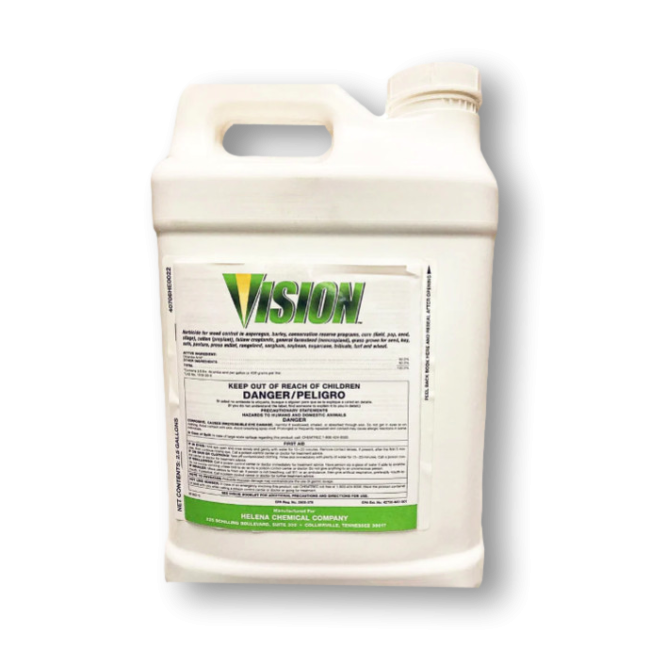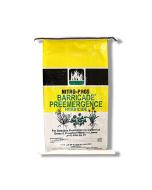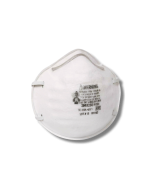Gain access to personalized product screening, the best pricing, rewards, and more!
Vision Herbicide
Vision Herbicide is a unique professional post-emergent herbicide that provides serious broadleaf weed, vines, and brush control in rangelands, forests, crops, and non-crop areas.
01/11/26
Vision Herbicide, manufactured by Helena Chemicals, is an effective systemic, post-emergent herbicide for controlling over 150 tough broadleaf weeds, vines, and woody brush in various crops, turf, industrial, and utility areas.
Thanks to its Moveo formulation, Vision Herbicide enhances coverage, absorption, and tank-mixing compatibility all while offering low volatility and minimal odor. That makes it a go-to solution for professionals seeking exceptional weed control without unwanted drift. Unlike some dicamba products, this product has low volatility and odor, significantly reducing the risk of drift damage in sensitive zones.
Vision Herbicide acid-dicamba base fortified with Moveo puts it ahead of traditional ester options, ensuring precision, safety, and peace of mind for turf professionals.
Tools Needed
A backpack sprayer, handheld sprayer, spray rig, or aircraft will be needed.
How to Use
- Step 1: Determine how much Vision Herbicide to use by measuring the square footage of the treatment area. Find the square footage by measuring the treatment area's length and width in feet, then multiply them together (length X width = square footage). For acreage, take the square footage and divide it by one acre (square footage / 43,560 sq. ft. = acres). To treat residential, recreational, or institutional turf and lawns, or sod farms, apply 8 to 24 fl. oz. of Vision Herbicide per 30 to 200 gallons of water per acre to control annual weeds. For perennial weed control in residential, recreational, or institutional turf and lawns, or sod farms use 16 to 32 fl. oz. of product per 30 to 200 gallons of water per acre. Do not make more than 2 applications per year of turf and lawn. Refer to the product label for specific application rates and restrictions.
- Step 2: Start by filling the tank with half the amount of water, add the recommended rate of product, and pour in the remaining half of the water. Close the tank lid and agitate well.
- Step 3: Apply to the top and bottom of weed leaves until wet, but not to the point of runoff. Avoid spray drift to unlisted foliage as injury may result. Do not make repeat applications in treated areas for 30 days and until previous applications of this product have been activated in the soil by rain or irrigation.
Where to Use
Vision Herbicide can be used in asparagus, barley, conservation reserve programs, corn (field, pop, seed, silage), cotton (preplant), fallow croplands, general farmstead (noncropland), grass grown for seed, hay, oats, pasture, proso millet, rangeland, sorghum, soybean, sugarcane, triticale, turf, and wheat.
When to Use
Apply at any point in the season when weeds are present, except when the ground is frozen.
Safety Information
Vision Herbicide is safe for people and pets when applied according to the product label instructions. Always wear the proper personal protective equipment (PPE) when mixing and applying this product.
Do not allow people or pets to enter the treated area until 24 hours have passed after application or longer if the treatment area is not completely dry.
Special Considerations
This product may cause injury or death to desirable crops and ornamental plants, particularly beans, cotton, flowers, fruit trees, grapes, ornamentals (trees and shrubs), peas, potatoes, soybeans, sunflowers, tobacco, tomatoes, and other broadleaf plants when their roots, stems, or foliage are exposed to low levels. These plants are most sensitive to Vision Herbicide during their development or growth stage.
| Restricted Use | No |
|---|---|
| Shipping Restrictions | AK, AZ, CA, DC, HI, IN, SD, VA, VT |
| Availability | Online |
| Signal Word | DANGER |
| Keith's Pro Tip | "Use diverse crop rotations to disrupt weed life cycles and reduce species dominance." |
| Time to Kill | Within 2 weeks or more weeds will be killed. |
| Chemical Type | Herbicide |
| Formulation | Emulsifiable Concentrate (EC) |
| Application Methods | Broadcast Spray, Spot Treatment |
| Product Drawbacks | Adjuvants containing crop oil concentrates may be used in preplant, pre-emergence, and preharvest applications as well as in pastures and noncropland. Do not use crop oil concentrate for postemergence in-crop applications. |
| Active Ingredient | Dicamba Acid 40.0% |
| Application Equipment | Backpack Sprayer, Pump Sprayer, Spray Rig |
| Mix Rate | To treat residential, recreational, or institutional turf and lawns, or sod farms, apply 8 to 24 fl. oz. of Vision Herbicide per 30 to 200 gallons of water per acre to control annual weeds. For perennial weed control in residential, recreational, or institutional turf and lawns, or sod farms use 16 to 32 fl. oz. of product per 30 to 200 gallons of water per acre. |
| Use Sites | Outdoors |
| Yield | 2.5 gallons of Vision Herbicide will cover 13 acres. |
| EPA Registration No. | 5905-576 |
| Shelf Life | Vision Herbicide will last for 3 years when stored in a dry, clean area. |
| Comparable Products | Endrun Turf Herbicide (2, 4-D Mecoprop Dicamba) |
| Children or pets? | Yes |
| Property Characteristics | None |
| Availability | Online |
| Restricted Use | No |
| Brand | HELENA CHEMICALS |
| Keith's Pro Tips | "Use diverse crop rotations to disrupt weed life cycles and reduce species dominance." |
| Product Drawbacks | Adjuvants containing crop oil concentrates may be used in preplant, pre-emergence, and preharvest applications as well as in pastures and noncropland. Do not use crop oil concentrate for postemergence in-crop applications. |
| Target Pests | Absinth Wormwood, Alder, Alfalfa, Alkanet, American Dragonhead, Annual Fleabane, Annual Sowthistle, Ash, Aspen, Bachelor'S Button, Bahiagrass, Barnyardgrass, Basswood, Beardgrass, Bermudagrass, Big Bluestems, Birch, Bitter Rubberweed, Bitter Sneezeweed, Bitterdock, Black Henbane, Black Knapweed, Black Locust, Black Mustard, Black Nightshade, Blackberry, Blackgum, Bladder Campion, Blue Mustard, Bracted Plantain, Bristly Starbur, Broadleaf Dock, Broadleaf Plantain, Broom Snakeweed, Buckhorn Plantain, Buckvine, Buffalobur, Bull Thistle, Bur Chervil, Bur Ragweed, Burcucumber, California Burclover, Canada Bluegrass, Canada Thistle, Carolina Geranium, Carolina Horsenettle, Carpetweed, Catchweed Bedstraw, Cattail, Cedar, Cheat, Cherry, Chicory, Chinquapin, Climbing Milkweed, Clover, Cogongrass, Common Broomweed, Common Burdock, Common Chickweed, Common Cocklebur, Common Eveningprimrose, Common Goldenweed, Common Lambsquarters, Common Mallow, Common Milkweed, Common Purslane, Common Ragweed, Common Spikeweed, Common Sunflower, Common Waterhemp, Common Yarrow, Corn Buttercup, Corn Cockle, Corn Spurry, Cornflower, Cottonwood, Cow Cockle, Crabgrass, Creeping Buttercup, Creeping Waterprimrose, Creeping Woodsorrel, Creosotebush, Crowfootgrass, Cucumbertree, Curly Dock, Dallisgrass, Dalmatian Toadflax, Dandelion, Dewberry, Diffuse Knapweed, Dogfennel, Dogwood, Downy Brome, Dwarf Mallow, Eastern Persimmon, Eastern Red Cedar, Elm, English Daisy, Fall Panicum, Feathertop, Field Bindweed, Field Chickweed, Field Pennycress, Flixweed, Florida Beggarweed, Florida Pusley, Fringed Sagebrush, Fumitory, German Moss, Giant Ragweed, Giant Reed, Goosegrass, Grape, Green Smartweed, Gromwell, Guineagrass, Hawkweed, Hawthorn, Hedge Bindweed, Hemlock, Hemp Dogbane, Hemp Sesbania, Hempnettle, Henbit, Hickory, Honeylocust, Honeysuckle, Hop Clover, Hophornbeam Copperleaf, Hornbeam, Horseweed, Huckleberry, Huisache, Ironweed, Itchgrass, Ivyleaf Morningglory, Jacob'S Ladder, Jerusalem Artichoke, Jimsonweed, Kentucky Bluegrass, Knawel, Kochia, Kudzu, Ladysthumb, Lanceleaf Ragweed, Leafy Spurge, Little Starwort, London Rocket, Louisiana Wormwood, Lovegrass, Macartney Rose, Maple, Marestail, Mayweed, Mesquite, Minerslettuce, Missouri Goldenrod, Mouseear Chickweed, Multiflora Rose, Musk Thistle, Nettleleaf Goosefoot, Nightflowering Catchfly, Oak, Palmer Amaranth, Panicum, Pennsylvania Smartweed, Perennial Sowthistle, Phragmites, Pine, Pineappleweed, Pinegrass, Plumeless Thistle, Poison Ivy, Poison Oak, Pokeweed, Poorjoe, Poplar, Povertyweed, Powell Amaranth, Prairie Cordgrass, Prairie Threeawn, Prickly Lettuce, Prickly Sida, Prostrate Knotweed, Prostrate Pigweed, Prostrate Spurge, Puncturevine, Quackgrass, Rabbitbrush, Red Sorrel, Redroot Pigweed, Redvine, Reed Canarygrass, Rough Sumpweed, Roughseed Buttercup, Russian Knapweed, Russian Olive, Russian Thistle, Salsify, Saltgrass, Sand Dropseed, Sand Plum, Sandbur, Sassafras, Scotch Thistle, Servicea Lespediza, Serviceberry, Sheep Sorrel, Shepherdspurse, Sicklepod, Silverleaf Nightshade, Slender Aster, Smallseed Falseflax, Smooth Bedstraw, Smooth Brome, Spicebush, Spiny Amaranth, Spiny Aster, Spiny Sowthistle, Spotted Knapweed, Sprangletop, Spruce, Stinging Nettle, Sumac, Swamp Smartweed, Sweetclover, Sweetgum, Sycamore, Tall Buttercup, Tall Morningglory, Tall Waterhemp, Tansy Ragwort, Tansymustard, Tarbush, Tartary Buckwheat, Teasel, Texas Blueweed, Thornapple, Timothy, Torpedograss, Treacle Mustard, Tropic Croton, Tropical Soda Apple, Trumpetcreeper, Tumble Mustard, Vaseygrass, Velvetleaf, Venice Mallow, Vetch, Virginia Pepperweed, Western Field Buttercup, Western Ragweed, Western Whorled Milkweed, White Cockle, White Heath Aster, White Horsenettle, Wild Barley, Wild Buckwheat, Wild Carrot, Wild Garlic, Wild Mustard, Wild Oat, Wild Onion, Wild Plum, Wild Radish, Wild Sunflower, Willow, Winged Waterprimrose, Wirestem Muhly, Witchgrass, Witchhazel, Woolly Croton, Wooly Cupgrass, Woolyleaf Bursage, Wormwood, Yankeeweed, Yaupon, Yellow Rocket, Yellow Starthistle, Yellow Woodsorrel, and Yucca. |
| Application Equipment | Backpack Sprayer, Pump Sprayer, Spray Rig |
| Application Methods | Broadcast Spray, Spot Treatment |
| Active Ingredient | Dicamba Acid 40.0% |
| Product Type | Herbicide |
| Formulation | Emulsifiable Concentrate (EC) |
| Application Rate | To treat residential, recreational, or institutional turf and lawns, or sod farms, apply 8 to 24 fl. oz. of Vision Herbicide per 30 to 200 gallons of water per acre to control annual weeds. For perennial weed control in residential, recreational, or institutional turf and lawns, or sod farms use 16 to 32 fl. oz. of product per 30 to 200 gallons of water per acre. |
| Shelf Life | Vision Herbicide will last for 3 years when stored in a dry, clean area. |
| Yield | 2.5 gallons of Vision Herbicide will cover 13 acres. |
| Use Sites | Outdoors |
| Time to Kill | Within 2 weeks or more weeds will be killed. |
| Comparable Products | Endrun Turf Herbicide (2, 4-D Mecoprop Dicamba) |
| Use Caution With | St Augustine |
| Incompatible Home Siding | Brick, Hardie Plank, Stone Veneer, Stucco, Wood, Vinyl |
| EPA Registration # | 5905-576 |
*Price does not include freight. We guarantee our rate plus shipping will be less than anyone else's price.














